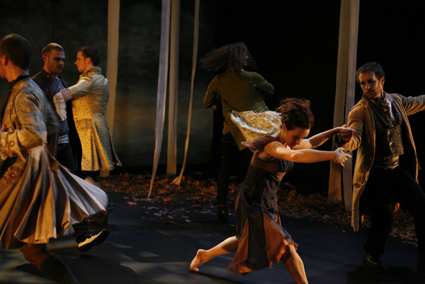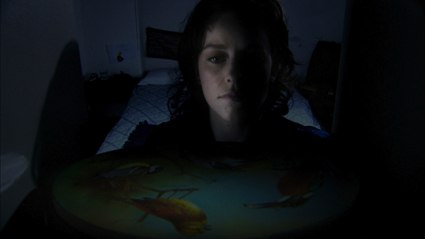the life in the work
philipa rothfield: tracie mitchell, dance screen retrospective

Under the Weather (2008), Tracie Mitchell
courtesy the artist
Under the Weather (2008), Tracie Mitchell
MANY WORDS HAVE BEEN WRITTEN ABOUT WHETHER TO APPROACH ART IN TERMS OF THE WORK ALONE OR IN RELATION TO THE ARTIST. TO WHAT EXTENT DOES THE ARTWORK SPEAK FOR ITSELF, AND TO WHAT EXTENT OUGHT IT BE VIEWED THROUGH THE PERSONA OF THE ARTIST?
Retrospectives are a great way to circumvent this dilemma because we can see the life work of the person without needing to resort to biography. Life is in the works, plural.
Tracie Mitchell has produced a body of dance films spanning some 25 years. It was an inspired decision on the part of Angela Conquet, artistic director of Dancehouse, to show all these works together. Not only do they reflect a significant creative output, they offer the viewer an opportunity to flit between films, to experience their differences and to allow the experience of one to influence the other.
Predictably, the works were shown in chronological order. From a blurred three-minute ‘haiku’ (Whitehouse #1, 1985) to an extended, full colour film, the common denominator is Mitchell’s own developing eye.
Time changes everything though. Many of the performers from these films were sitting in the audience, draped over beanbags, watching their former selves onscreen. Mitchell was herself present and primed to share this greater part of her own life. So the viewing experience, quite apart from the films, was redolent with the passage of time in that Proustian sense.
Cinema is itself a succession of temporal captures, which in their serial multiplicity stage a complex choreography of movement. Beginning at the beginning, I loved watching three minutes culled from an event staged long ago. Grainy images of phrase material paced out inside an industrial building give an inkling of what’s to come.
Mitchell’s second film, Chicken (1990), is a poetic, slow motion meditation of a group performance, often watched in canon. Set in a car park overlooking railway tracks, the black and white imagery exhibits a considered construction of the viewer’s perspective. Turns and spirals, dips and kicks are played out in exuberant fashion, peppered with flashes of inner urban landscape. The poetics of the imagery arises in waves. Thread (1994) extends this notion of partial perspective, according to which the camera itself makes choices which we inherit. Sure (1998) is pretty much my favourite film, I’m not sure why. The makeup of the many female dancers is quite stark, and their looks to camera a bit contrived and yet their dancing, composure, and close relationship to the camera express a kinaesthetic empathy that is a pleasure to watch.

Whole Heart (2005), Tracie Mitchell
courtesy the artist
Whole Heart (2005), Tracie Mitchell
Whole Heart (2005) is much more narrative-based, a scary account of female vulnerability and sexual violence, which reminds us that each young woman was once a child. It contains some unaccountably beautiful images of peeling wallpaper, unravelling the patina of time. Finally there was Under the Weather (2008), a colour saturated account of women’s dreams and fears.
These films are not a trajectory leading to some end. They are each fulsome in their own right. But seeing them together was something else, an opportunity to experience a different kind of beast, crisscrossing time, courtesy of a life in the works.
–
Dance Massive, Dancehouse, with Keir Foundation: Tracie Mitchell, Dance Screen Retrospective 1985-2008, Dancehouse, Melbourne, March 23, 24; http://dancemassive.com.au






